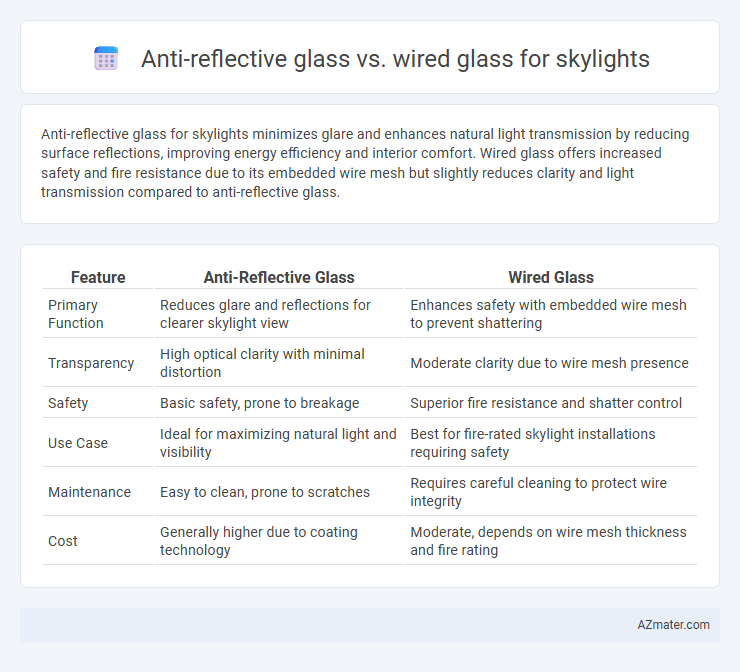Anti-reflective glass for skylights minimizes glare and enhances natural light transmission by reducing surface reflections, improving energy efficiency and interior comfort. Wired glass offers increased safety and fire resistance due to its embedded wire mesh but slightly reduces clarity and light transmission compared to anti-reflective glass.
Table of Comparison
| Feature | Anti-Reflective Glass | Wired Glass |
|---|---|---|
| Primary Function | Reduces glare and reflections for clearer skylight view | Enhances safety with embedded wire mesh to prevent shattering |
| Transparency | High optical clarity with minimal distortion | Moderate clarity due to wire mesh presence |
| Safety | Basic safety, prone to breakage | Superior fire resistance and shatter control |
| Use Case | Ideal for maximizing natural light and visibility | Best for fire-rated skylight installations requiring safety |
| Maintenance | Easy to clean, prone to scratches | Requires careful cleaning to protect wire integrity |
| Cost | Generally higher due to coating technology | Moderate, depends on wire mesh thickness and fire rating |
Introduction to Skylight Glass Options
Skylight glass options prominently include anti-reflective glass and wired glass, each offering unique benefits tailored to specific architectural needs. Anti-reflective glass enhances natural light transmission while minimizing glare and reflections, creating clearer and brighter skylight installations. Wired glass provides enhanced safety and fire resistance due to its embedded wire mesh, making it suitable for skylights requiring additional security and code compliance.
What is Anti-Reflective Glass?
Anti-reflective glass is specially coated to minimize glare and reflections, enhancing natural light transmission through skylights by up to 99%. This type of glass improves visibility and energy efficiency by reducing solar heat gain and optimizing daylight penetration. In contrast to wired glass, which prioritizes strength and safety but compromises clarity, anti-reflective glass offers superior optical performance essential for maximizing the benefits of skylight installations.
What is Wired Glass?
Wired glass is a type of safety glass embedded with a metal wire mesh that enhances its fire resistance and prevents shattering upon impact. Commonly used in skylights for added security and fire protection, wired glass provides durability but can reduce clarity and light transmission compared to anti-reflective glass. Anti-reflective glass offers superior visibility and natural light diffusion, making it an optimal choice for skylights where aesthetic and light performance are priorities.
Light Transmission: Anti-Reflective vs Wired Glass
Anti-reflective glass for skylights typically offers light transmission rates above 90%, significantly reducing glare and enhancing natural daylight penetration. Wired glass, while providing increased safety and fire resistance, generally has lower light transmission due to embedded wire mesh, resulting in reduced brightness and slightly diffused light. Choosing anti-reflective glass maximizes clear, unobstructed light flow, whereas wired glass prioritizes structural safety with some trade-off in light quality.
Impact on Energy Efficiency
Anti-reflective glass enhances skylight energy efficiency by maximizing natural light transmission while minimizing heat loss, reducing reliance on artificial lighting and heating. Wired glass, often thicker and less transparent, tends to decrease energy efficiency due to reduced solar gain and increased thermal resistance. Choosing anti-reflective glass optimizes daylight utilization and supports lower energy consumption in buildings.
Safety and Security Comparison
Anti-reflective glass for skylights enhances visibility and reduces glare while providing moderate impact resistance, making it suitable for areas prioritizing clear views and light transmission. Wired glass offers superior safety by maintaining structural integrity during breakage, as embedded wires prevent shattering and reduce the risk of injury, making it ideal for high-security applications. While anti-reflective glass excels in clarity and daylight performance, wired glass provides enhanced protection against forced entry and accidental impact, ensuring greater security in sensitive installations.
Aesthetic Differences
Anti-reflective glass for skylights offers a clear, unobstructed view with minimal glare, enhancing natural light transmission and providing a sleek, modern appearance. Wired glass features a distinctive embedded wire mesh pattern that can disrupt visual clarity, giving a more industrial and utilitarian aesthetic. The clean transparency of anti-reflective glass is preferred for designs emphasizing openness, while wired glass suits environments valuing enhanced safety with a textured, patterned look.
Maintenance Requirements
Anti-reflective glass for skylights significantly reduces glare and enhances natural light transmission while requiring minimal maintenance, as its coating resists dust and dirt buildup. Wired glass, often used for safety and security, demands more frequent cleaning and inspections due to its textured surface and embedded wire mesh, which can trap debris and complicate upkeep. Choosing anti-reflective glass helps lower long-term maintenance efforts and costs, ensuring clearer skylight performance with less intervention.
Cost Considerations
Anti-reflective glass for skylights generally incurs higher upfront costs due to advanced coating technologies that enhance light transmission and reduce glare. Wired glass tends to be more cost-effective initially but may require additional maintenance and replacement expenses over time due to its susceptibility to rust and lower optical clarity. Long-term cost considerations should balance initial investment with durability, safety standards, and energy efficiency benefits.
Choosing the Best Skylight Glass for Your Needs
Anti-reflective glass maximizes natural light transmission and reduces glare, making it ideal for skylights in areas requiring clear, unobstructed views and energy efficiency. Wired glass offers enhanced safety and fire resistance, suitable for skylights in commercial buildings or locations with strict building codes. Selecting the best skylight glass depends on balancing factors such as light clarity, safety regulations, and intended use, ensuring optimal performance and occupant protection.

Infographic: Anti-reflective glass vs Wired glass for Skylight
 azmater.com
azmater.com